Wildfire Trend Analysis over the Contiguous United States Using Remote Sensing Observations
Abstract
1. Introduction
2. Materials and Methods
2.1. Wildfire Data
2.2. Methods
3. Results
3.1. Total Burned Area Trends of the Nine GACC Regions
3.2. Frequency Trends of the Nine GACC Regions
3.3. Average Burned Area of the Nine GACC Regions
4. Discussion
5. Conclusions
Author Contributions
Funding
Acknowledgments
Conflicts of Interest
References
- McWethy, D.B.; Schoennagel, T.; Higuera, P.E.; Krawchuk, M.; Harvey, B.J.; Metcalf, E.C.; Schultz, C.; Miller, C.; Metcalf, A.L.; Buma, B.; et al. Rethinking Resilience to Wildfire. Nat. Sustain. 2019, 2, 797–804. [Google Scholar] [CrossRef]
- Moritz, M.A.; Batllori, E.; Bradstock, R.A.; Gill, A.M.; Handmer, J.; Hessburg, P.F.; Leonard, J.; McCaffrey, S.; Odion, D.C.; Schoennagel, T.; et al. Learning to Coexist with Wildfire. Nature 2014, 515, 58–66. [Google Scholar] [CrossRef] [PubMed]
- USDA/FS. The Rising Cost of Wildfire Operations: Effect on the Forest Service’s Non-Fire Work. Available online: https://www.fs.usda.gov/sites/default/files/2015-Fire-Budget-Report.pdf (accessed on 27 July 2020).
- Bowman, D.M.J.S.; Balch, J.K.; Artaxo, P.; Bond, W.J.; Carlson, J.M.; Cochrane, M.A.; D’Antonio, C.M.; DeFries, R.S.; Doyle, J.C.; Harrison, S.P.; et al. Fire in the Earth System. Science 2009, 324, 481–485. [Google Scholar] [CrossRef] [PubMed]
- Finco, M.; Quayle, B.; Zhang, Y.; Lecker, J.; Megown, K.A.; Brewer, K.C. Monitoring Trends and Burn Severity (MTBS): Monitoring Wildfire Activity for the Past Quarter Century Using Landsat Data. In Proceedings of the Forest Inventory and Analysis (FIA) Symposium 2012, Baltimore, MD, USA, 4–6 December 2012; p. 7. [Google Scholar]
- Calkin, D.E.; Thompson, M.P.; Finney, M.A.; Hyde, K.D. A Real-Time Risk Assessment Tool Supporting Wildland Fire Decisionmaking. J. For. 2011, 109, 274–280. [Google Scholar]
- Abatzoglou, J.T.; Kolden, C.A. Relationships between Climate and Macroscale Area Burned in the Western United States. Int. J. Wildland Fire 2013, 22, 1003. [Google Scholar] [CrossRef]
- National Geographic Coordination Centers Website Portal about Us Page. Available online: https://gacc.nifc.gov/admin/about_us/about_us.htm (accessed on 1 June 2020).
- Kolden, C.A. We’re Not Doing Enough Prescribed Fire in the Western United States to Mitigate Wildfire Risk. Fire 2019, 2, 30. [Google Scholar] [CrossRef]
- Farahmand, A.; Stavros, E.N.; Reager, J.T.; Behrangi, A.; Randerson, J.T.; Quayle, B. Satellite Hydrology Observations as Operational Indicators of Forecasted Fire Danger across the Contiguous United States. Nat. Hazards Earth Syst. Sci. 2020, 20, 1097–1106. [Google Scholar] [CrossRef]
- Flannigan, M.D.; Wotton, B.M.; Marshall, G.A.; de Groot, W.J.; Johnston, J.; Jurko, N.; Cantin, A.S. Fuel Moisture Sensitivity to Temperature and Precipitation: Climate Change Implications. Clim. Chang. 2016, 134, 59–71. [Google Scholar] [CrossRef]
- Albano, C.M.; Dettinger, M.D.; Soulard, C.E. Influence of Atmospheric Rivers on Vegetation Productivity and Fire Patterns in the Southwestern U.S.: Atmospheric River Effects on. J. Geophys. Res. Biogeosci. 2017, 122, 308–323. [Google Scholar] [CrossRef]
- Xiao, J.; Zhuang, Q. Drought Effects on Large Fire Activity in Canadian and Alaskan Forests. Environ. Res. Lett. 2007, 2, 044003. [Google Scholar] [CrossRef]
- Shabbar, A.; Skinner, W.; Flannigan, M.D. Prediction of Seasonal Forest Fire Severity in Canada from Large-Scale Climate Patterns. J. Appl. Meteorol. Climatol. 2011, 50, 785–799. [Google Scholar] [CrossRef]
- Abatzoglou, J.T.; Kolden, C.A. Climate Change in Western US Deserts: Potential for Increased Wildfire and Invasive Annual Grasses. Rangel. Ecol. Manag. 2011, 64, 471–478. [Google Scholar] [CrossRef]
- Archer, S.R.; Predick, K.I. Climate Change and Ecosystems of the Southwestern United States. Rangelands 2008, 30, 23–28. [Google Scholar] [CrossRef]
- Barbero, R.; Abatzoglou, J.T.; Kolden, C.A.; Hegewisch, K.C.; Larkin, N.K.; Podschwit, H. Multi-Scalar Influence of Weather and Climate on Very Large-Fires in the Eastern United States: Weather, climate and very large-fires in the eastern united states. Int. J. Clim. 2015, 35, 2180–2186. [Google Scholar] [CrossRef]
- Westerling, A.L. Warming and Earlier Spring Increase Western U.S. Forest Wildfire Activity. Science 2006, 313, 940–943. [Google Scholar] [CrossRef]
- Littell, J.S.; McKenzie, D.; Peterson, D.L.; Westerling, A.L. Climate and Wildfire Area Burned in Western U.S. Ecoprovinces, 1916–2003. Ecol. Appl. 2009, 19, 1003–1021. [Google Scholar] [CrossRef]
- Jensen, D.; Reager, J.T.; Zajic, B.; Rousseau, N.; Rodell, M.; Hinkley, E. The Sensitivity of US Wildfire Occurrence to Pre-Season Soil Moisture Conditions across Ecosystems. Environ. Res. Lett. 2018, 13, 014021. [Google Scholar] [CrossRef]
- Dennison, P.E.; Brewer, S.C.; Arnold, J.D.; Moritz, M.A. Large Wildfire Trends in the Western United States, 1984-2011: Large wildfire trends in the western us. Geophys. Res. Lett. 2014, 41, 2928–2933. [Google Scholar] [CrossRef]
- Nagy, R.C.; Fusco, E.; Bradley, B.; Abatzoglou, J.T.; Jennifer, B. Human-Related Ignitions Increase the Number of Large Wildfires across U.S. Ecoregions. Fire 2018, 1, 4. [Google Scholar] [CrossRef]
- Balch, J.K.; Bradley, B.A.; Abatzoglou, J.T.; Nagy, R.C.; Fusco, E.J.; Mahood, A.L. Human-Started Wildfires Expand the Fire Niche across the United States. Proc. Natl. Acad. Sci. USA 2017, 114, 2946–2951. [Google Scholar] [CrossRef]
- Barbero, R.; Abatzoglou, J.T.; Larkin, N.K.; Kolden, C.A.; Stocks, B. Climate Change Presents Increased Potential for Very Large Fires in the Contiguous United States. Int. J. Wildl. Fire 2015, 24, 892. [Google Scholar] [CrossRef]
- Abatzoglou, J.T.; Williams, A.P. Impact of Anthropogenic Climate Change on Wildfire across Western US Forests. Proc. Natl. Acad. Sci. USA 2016, 113, 11770–11775. [Google Scholar] [CrossRef]
- Cattau, M.E.; Wessman, C.; Mahood, A.; Balch, J.K. Anthropogenic and Lightning-started Fires Are Becoming Larger and More Frequent over a Longer Season Length in the U.S.A. Glob. Ecol. Biogeogr. 2020, 29, 668–681. [Google Scholar] [CrossRef]
- Radeloff, V.C.; Helmers, D.P.; Kramer, H.A.; Mockrin, M.H.; Alexandre, P.M.; Bar-Massada, A.; Butsic, V.; Hawbaker, T.J.; Martinuzzi, S.; Syphard, A.D.; et al. Rapid Growth of the US Wildland-Urban Interface Raises Wildfire Risk. Proc. Natl. Acad. Sci. USA 2018, 115, 3314–3319. [Google Scholar] [CrossRef]
- Short, K.C. A spatial database of wildfires in the United States, 1992–2011. Earth Syst. Sci. Data 2014, 1–27. [Google Scholar] [CrossRef]
- Malone, S.L.; Kobziar, L.N.; Staudhammer, C.L.; Abd-Elrahman, A. Modeling Relationships among 217 Fires Using Remote Sensing of Burn Severity in Southern Pine Forests. Remote Sens. 2011, 3, 2005–2028. [Google Scholar] [CrossRef]
- Szpakowski, D.M.; Jensen, J.L.R. A Review of the Applications of Remote Sensing in Fire Ecology. Remote Sens. 2019, 11, 2638. [Google Scholar] [CrossRef]
- Sankey, J.B.; Wallace, C.S.A.; Ravi, S. Phenology-Based, Remote Sensing of Post-Burn Disturbance Windows in Rangelands. Ecol. Indic. 2013, 30, 35–44. [Google Scholar] [CrossRef]
- Coen, J.L.; Schroeder, W. Use of Spatially Refined Satellite Remote Sensing Fire Detection Data to Initialize and Evaluate Coupled Weather-Wildfire Growth Model Simulations: Wildfire modeling using fire detection. Geophys. Res. Lett. 2013, 40, 5536–5541. [Google Scholar] [CrossRef]
- Eidenshink, J.; Schwind, B.; Brewer, K.; Zhu, Z.-L.; Quayle, B.; Howard, S. A Project for Monitoring Trends in Burn Severity. Fire Ecol. 2007, 3, 3–21. [Google Scholar] [CrossRef]
- Lutz, J.A.; Key, C.H.; Kolden, C.A.; Kane, J.T.; van Wagtendonk, J.W. Fire Frequency, Area Burned, and Severity: A Quantitative Approach to Defining a Normal Fire Year. Fire Ecol. 2011, 7, 51–65. [Google Scholar] [CrossRef]
- Barbero, R.; Abatzoglou, J.T.; Steel, E.A.; Larkin, N.K. Modeling Very Large-Fire Occurrences over the Continental United States from Weather and Climate Forcing. Environ. Res. Lett. 2014, 9, 124009. [Google Scholar] [CrossRef]
- Holden, Z.A.; Swanson, A.; Luce, C.H.; Jolly, W.M.; Maneta, M.; Oyler, J.W.; Warren, D.A.; Parsons, R.; Affleck, D. Decreasing Fire Season Precipitation Increased Recent Western US Forest Wildfire Activity. Proc. Natl. Acad. Sci. USA 2018, 115, E8349–E8357. [Google Scholar] [CrossRef] [PubMed]
- Mueller, S.E.; Thode, A.E.; Margolis, E.Q.; Yocom, L.L.; Young, J.D.; Iniguez, J.M. Climate Relationships with Increasing Wildfire in the Southwestern US from 1984 to 2015. For. Ecol. Manag. 2020, 460, 117861. [Google Scholar] [CrossRef]
- Williams, A.P.; Abatzoglou, J.T.; Gershunov, A.; Guzman-Morales, J.; Bishop, D.A.; Balch, J.K.; Lettenmaier, D.P. Observed Impacts of Anthropogenic Climate Change on Wildfire in California. Earth’s Future 2019, 7, 892–910. [Google Scholar] [CrossRef]
- Donovan, V.M.; Wonkka, C.L.; Twidwell, D. Surging Wildfire Activity in a Grassland Biome: Surging Wildfire Activity in a Grassland. Geophys. Res. Lett. 2017, 44, 5986–5993. [Google Scholar] [CrossRef]
- Calkin, D.E.; Thompson, M.P.; Finney, M.A. Negative Consequences of Positive Feedbacks in US Wildfire Management. For. Ecosyst. 2015, 2, 9. [Google Scholar] [CrossRef]
- Cochrane, M.A.; Moran, C.J.; Wimberly, M.C.; Baer, A.D.; Finney, M.A.; Beckendorf, K.L.; Eidenshink, J.; Zhu, Z. Estimation of Wildfire Size and Risk Changes Due to Fuels Treatments. Int. J. Wildl. Fire 2012, 21, 357. [Google Scholar] [CrossRef]
- Joseph, M.B.; Rossi, M.W.; Mietkiewicz, N.P.; Mahood, A.L.; Cattau, M.E.; St. Denis, L.A.; Nagy, R.C.; Iglesias, V.; Abatzoglou, J.T.; Balch, J.K. Spatiotemporal Prediction of Wildfire Size Extremes with Bayesian Finite Sample Maxima. Ecol. Appl. 2019, 29. [Google Scholar] [CrossRef]
- Kolden, C.A.; Smith, A.M.S.; Abatzoglou, J.T. Limitations and Utilisation of Monitoring Trends in Burn Severity Products for Assessing Wildfire Severity in the USA. Int. J. Wildl. Fire 2015, 24, 1023. [Google Scholar] [CrossRef]
- Parker, B.M.; Lewis, T.; Srivastava, S.K. Estimation and Evaluation of Multi-Decadal Fire Severity Patterns Using Landsat Sensors. Remote Sens. Environ. 2015, 170, 340–349. [Google Scholar] [CrossRef]
- Monitoring Trends in Burn Severity Website Frequently Asked Questions Page. Available online: https://www.mtbs.gov/faqs (accessed on 27 July 2020).
- United States Geological Survey Website Landsat Missions Page. Available online: https://www.usgs.gov/land-resources/nli/landsat/landsat-satellite-missions?qt-science_support_page_related_con=2#qt-science_support_page_related_con (accessed on 27 July 2020).
- Parks, S.; Dillon, G.; Miller, C. A New Metric for Quantifying Burn Severity: The Relativized Burn Ratio. Remote Sens. 2014, 6, 1827–1844. [Google Scholar] [CrossRef]
- Syphard, A.D.; Radeloff, V.C.; Keeley, J.E.; Hawbaker, T.J.; Clayton, M.K.; Stewart, S.I.; Hammer, R.B. Human influence on california fire regimes. Ecol. Appl. 2007, 17, 1388–1402. [Google Scholar] [CrossRef] [PubMed]
- Westerling, A.L. Increasing Western US Forest Wildfire Activity: Sensitivity to Changes in the Timing of Spring. Phil. Trans. R. Soc. B 2016, 371, 20150178. [Google Scholar] [CrossRef]
- Su, X.; Yan, X.; Tsai, C.-L. Linear Regression: Linear Regression. WIREs Comp. Stat. 2012, 4, 275–294. [Google Scholar] [CrossRef]
- Mann, H.B. Nonparametric Tests Against Trend. Econometrica 1945, 13, 245. [Google Scholar] [CrossRef]
- Kendall, M.G. Rank Correlation Methods, 4th ed.; Charles Griffin: London, UK, 1975; Available online: https://psycnet.apa.org/record/1948-15040-000 (accessed on 27 July 2020).
- Hamed, K.H.; Rao, A.R. A Modified Mann-Kendall Trend Test for Autocorrelated Data. J. Hydrol. 1998, 204, 182–196. [Google Scholar] [CrossRef]
- Yue, S.; Pilon, P.; Cavadias, G. Power of the Mann–Kendall and Spearman’s Rho Tests for Detecting Monotonic Trends in Hydrological Series. J. Hydrol. 2002, 259, 254–271. [Google Scholar] [CrossRef]
- Westerling, A.L.; Bryant, B.P. Climate Change and Wildfire in California. Clim. Chang. 2008, 87, 231–249. [Google Scholar] [CrossRef]
- Jin, Y.; Goulden, M.L.; Faivre, N.; Veraverbeke, S.; Sun, F.; Hall, A.; Hand, M.S.; Hook, S.; Randerson, J.T. Identification of Two Distinct Fire Regimes in Southern California: Implications for Economic Impact and Future Change. Environ. Res. Lett. 2015, 10, 094005. [Google Scholar] [CrossRef]
- Schoennagel, T.; Veblen, T.T.; Romme, W.H. The Interaction of Fire, Fuels, and Climate across Rocky Mountain Forests. Biol. Sci. 2004, 54, 661. [Google Scholar] [CrossRef]
- Williams, A.P.; Seager, R.; Berkelhammer, M.; Macalady, A.K.; Crimmins, M.A.; Swetnam, T.W.; Trugman, A.T.; Buenning, N.; Hryniw, N.; McDowell, N.G.; et al. Causes and Implications of Extreme Atmospheric Moisture Demand during the Record-Breaking 2011 Wildfire Season in the Southwestern United States. J. Appl. Meteorol. Climatol. 2014, 53, 2671–2684. [Google Scholar] [CrossRef]
- Mitchell, R.J.; Liu, Y.; O’Brien, J.J.; Elliott, K.J.; Starr, G.; Miniat, C.F.; Hiers, J.K. Future Climate and Fire Interactions in the Southeastern Region of the United States. For. Ecol. Manag. 2014, 327, 316–326. [Google Scholar] [CrossRef]
- National Interagency Coordination Center Website National Significant Wildland Fire Potential Outlook Page. Available online: https://www.nifc.gov/nicc/predictive/outlooks/outlooks.htm (accessed on 27 July 2020).
- Knapp, P.; Soulé, P. Spatio-Temporal Linkages between Declining Arctic Sea-Ice Extent and Increasing Wildfire Activity in the Western United States. Forests 2017, 8, 313. [Google Scholar] [CrossRef]
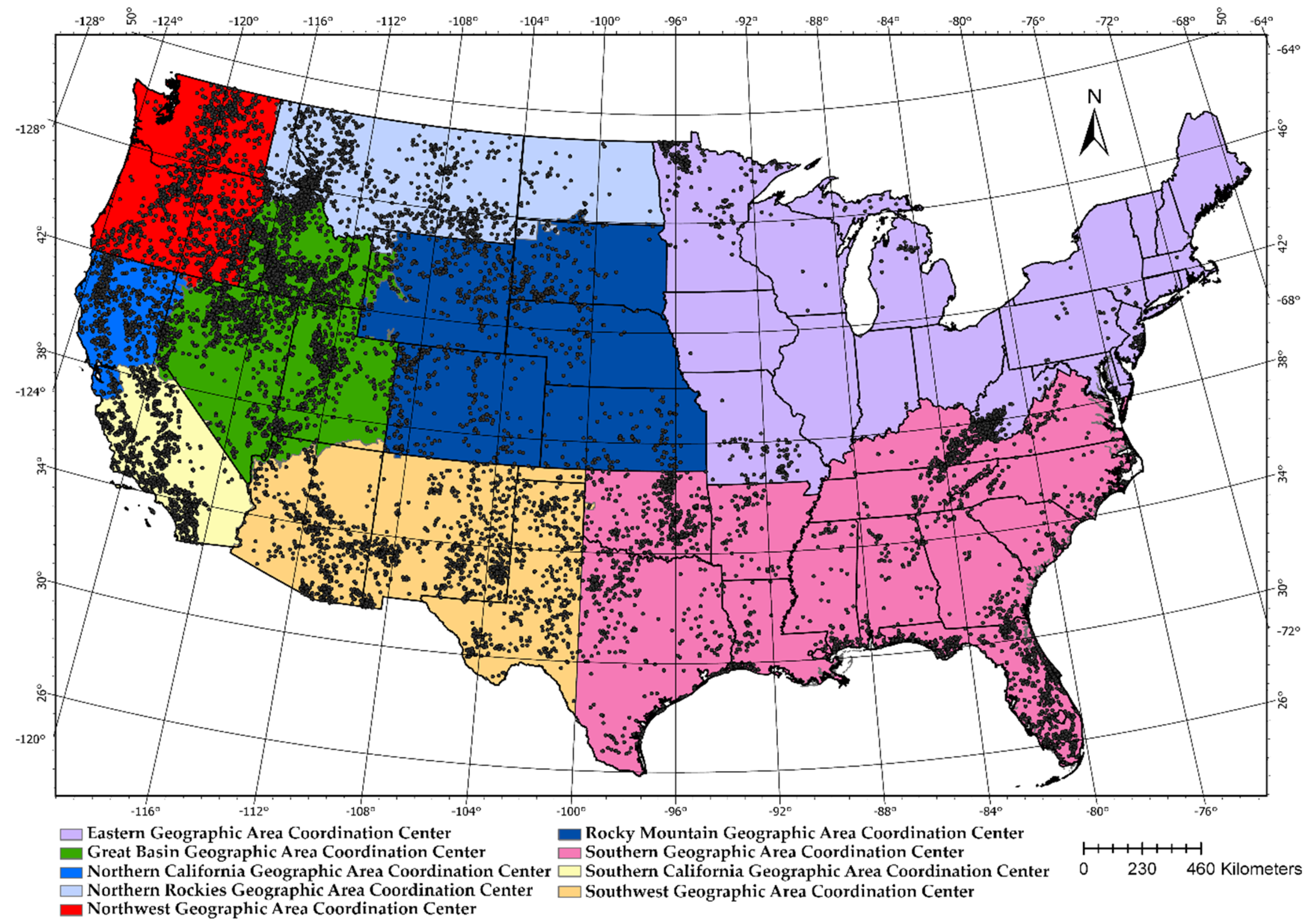
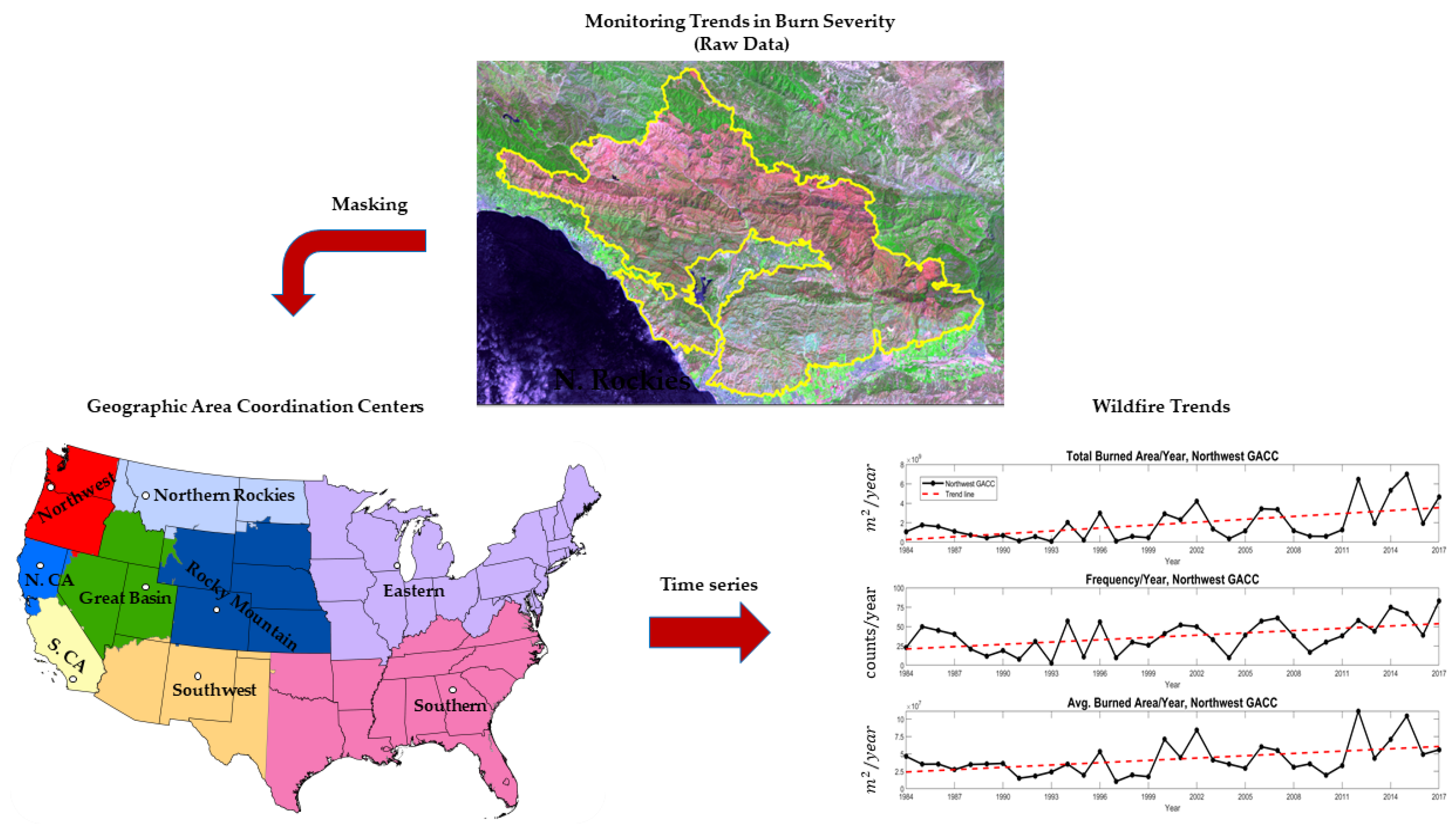
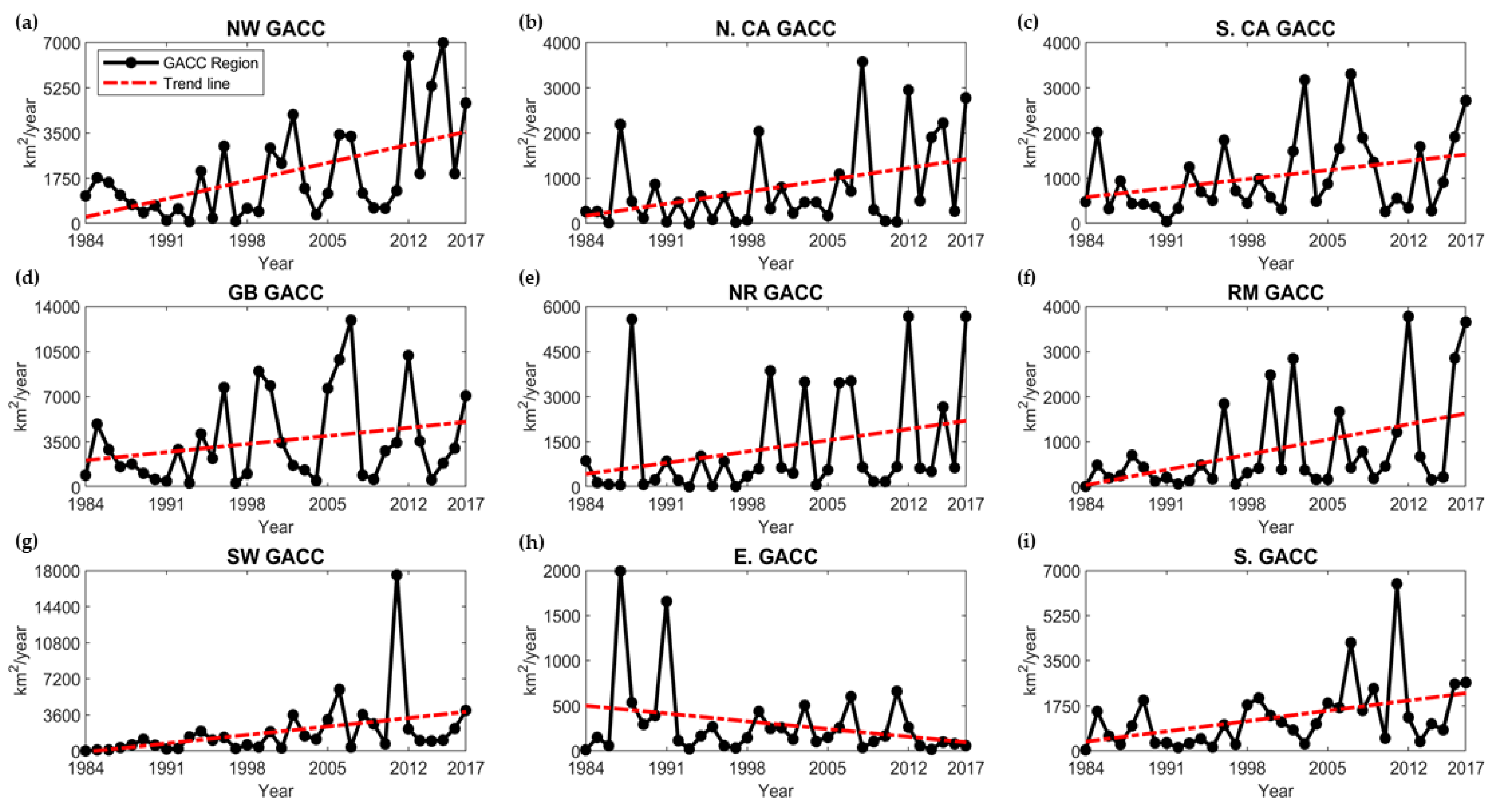
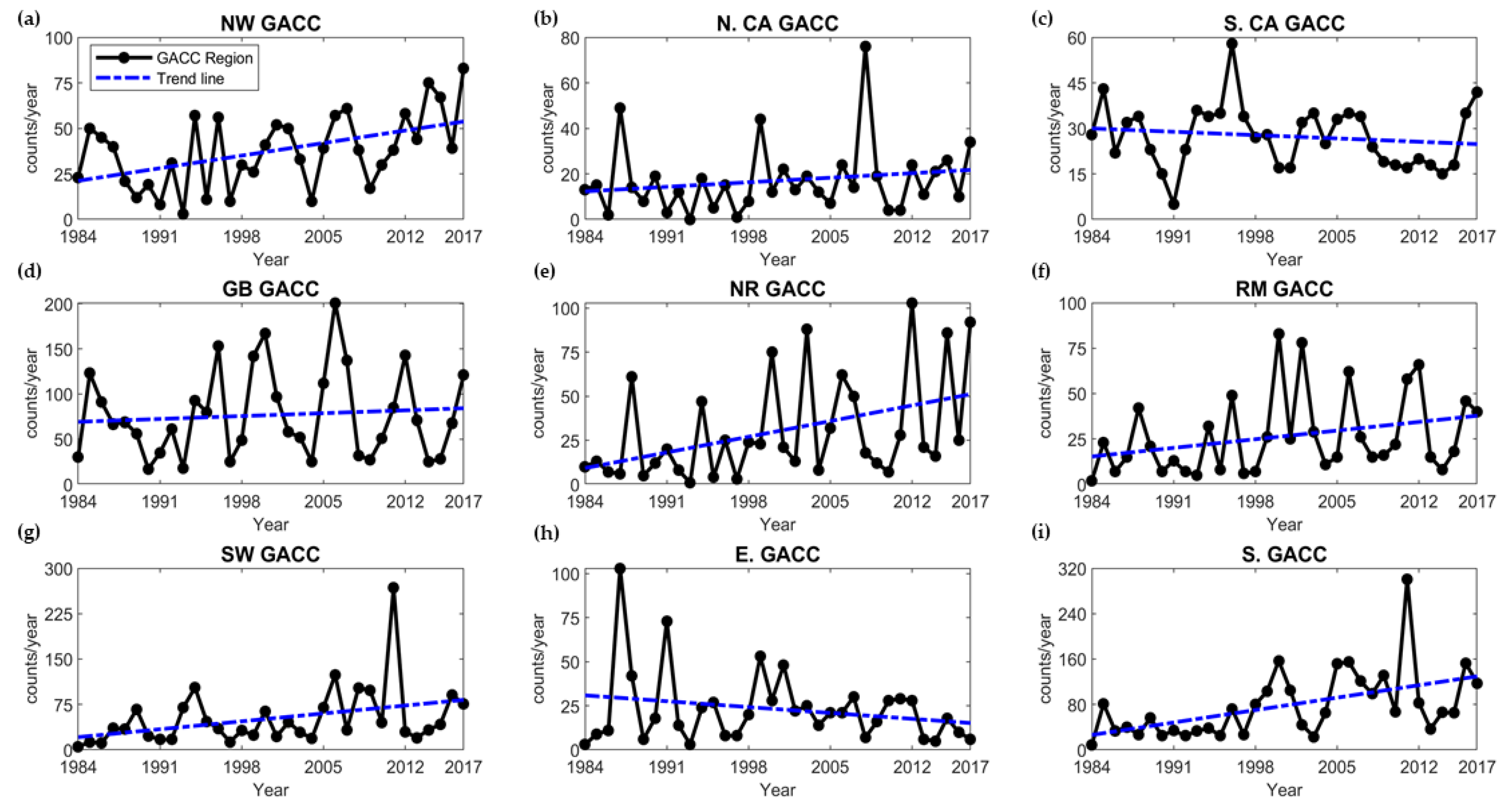
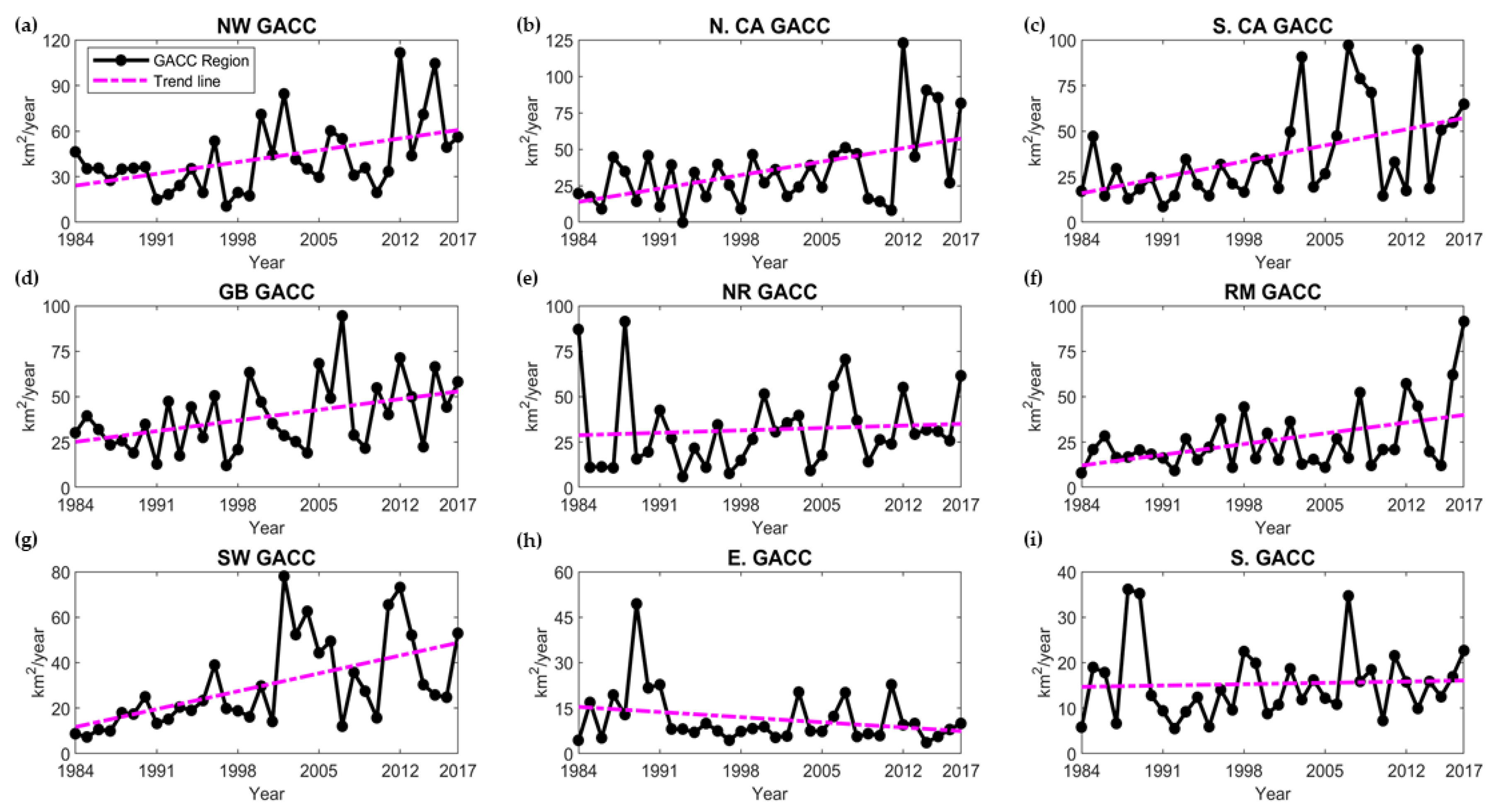
| Satellite Mission 1 | Sensor Type | Electromagnetic Spectrum Region 2 | Wavelength Range (μm) | Band Position |
|---|---|---|---|---|
| Landsat 4 (1982–1993) | Thematic Mapper | NIR | 0.76–0.90 | 4 |
| SWIR | 2.08–2.35 | 7 | ||
| Landsat 5 (1984–2013) | Thematic Mapper | NIR | 0.76–0.90 | 4 |
| SWIR | 2.08–2.35 | 7 | ||
| Landsat 7 (1999–Present) | Enhanced Thematic Mapper + | NIR | 0.77–0.90 | 4 |
| SWIR | 2.08–2.35 | 7 | ||
| Landsat 8 (2013–Present) | Operational Land Imager | NIR | 0.85–0.88 | 5 |
| SWIR2 | 2.11–2.29 | 7 |
| GACC Region | Parameter | Slope 1 | R2 | Trend Direction | Significance 2 (p < 0.05) |
|---|---|---|---|---|---|
| Total Burned Area | 99.85 | 0.30 | * | ||
| Northwest | Frequency | 0.99 | 0.24 | * | |
| Avg. Burned Area | 1.11 | 0.22 | * | ||
| Total Burned Area | 37.78 | 0.15 | |||
| N. California | Frequency | 0.29 | 0.03 | ||
| Avg. Burned Area | 1.32 | 0.24 | * | ||
| Total Burned Area | 28.50 | 0.11 | |||
| S. California | Frequency | −0.16 | 0.02 | ||
| Avg. Burned Area | 1.25 | 0.24 | * | ||
| Total Burned Area | 90.17 | 0.07 | |||
| Great Basin | Frequency | 0.46 | 0.009 | ||
| Avg. Burned Area | 0.84 | 0.19 | * | ||
| Total Burned Area | 53.59 | 0.09 | * | ||
| N. Rockies | Frequency | 1.27 | 0.19 | * | |
| Avg. Burned Area | 0.19 | 0.008 | |||
| Total Burned Area | 48 | 0.20 | * | ||
| Rocky Mtn | Frequency | 0.68 | 0.1 | * | |
| Avg. Burned Area | 0.84 | 0.21 | |||
| Total Burned Area | 120.48 | 0.15 | * | ||
| Southwest | Frequency | 1.87 | 0.14 | * | |
| Avg. Burned Area | 1.12 | 0.32 | * | ||
| Total Burned Area | −12.27 | 0.08 | |||
| Eastern | Frequency | −0.48 | 0.05 | ||
| Avg. Burned Area | −0.24 | 0.07 | |||
| Total Burned Area | 57.04 | 0.19 | * | ||
| Southern | Frequency | 3.13 | 0.28 | * | |
| Avg. Burned Area | 0.04 | 0.003 |
© 2020 by the authors. Licensee MDPI, Basel, Switzerland. This article is an open access article distributed under the terms and conditions of the Creative Commons Attribution (CC BY) license (http://creativecommons.org/licenses/by/4.0/).
Share and Cite
Salguero, J.; Li, J.; Farahmand, A.; Reager, J.T. Wildfire Trend Analysis over the Contiguous United States Using Remote Sensing Observations. Remote Sens. 2020, 12, 2565. https://doi.org/10.3390/rs12162565
Salguero J, Li J, Farahmand A, Reager JT. Wildfire Trend Analysis over the Contiguous United States Using Remote Sensing Observations. Remote Sensing. 2020; 12(16):2565. https://doi.org/10.3390/rs12162565
Chicago/Turabian StyleSalguero, John, Jingjing Li, Alireza Farahmand, and John T. Reager. 2020. "Wildfire Trend Analysis over the Contiguous United States Using Remote Sensing Observations" Remote Sensing 12, no. 16: 2565. https://doi.org/10.3390/rs12162565
APA StyleSalguero, J., Li, J., Farahmand, A., & Reager, J. T. (2020). Wildfire Trend Analysis over the Contiguous United States Using Remote Sensing Observations. Remote Sensing, 12(16), 2565. https://doi.org/10.3390/rs12162565






